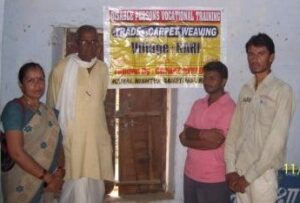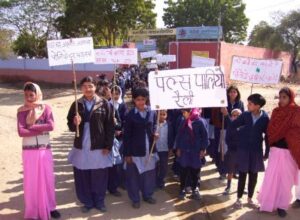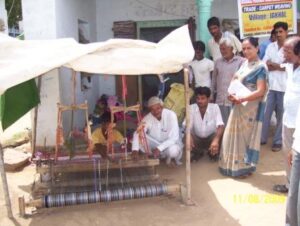Enable the Differently-abled
Rural Development through Income Generating Activities for Differently-abled People
Duration of the Project: April 1, 2009 to March 31, 2011.
Funding Agency: Council for Advancement of People’s Action and Rural Technology (CAPART) (Presently known as National Institute of Rural Development (NIRD)), Ministry of Rural Development, Govt. of India.
People with disabilities are heterogeneous groups composed of those born with a disability, as well as those who became disabled as a result of accidents or the trauma of events in lives. Their disabilities may be extensive or moderate and they may have a single disability or be disabled in multiple ways. The proportion of disabled in India as per census 2011 is 2.21% of the total population. Classification of the total disabled population by residence shows that the majority (69%) of the disabled population resides in rural areas while most of the country’s rehabilitation centers are situated in urban areas. The rural poor are particularly at risk of those disabilities, which are associated with motivation, poor conditions of environmental sanitation, and communicable diseases. Accidents arising from negligence, ignorance, and lack of safety measures at work and the community are also major causes of disabilities. Studies conducted by various organizations pointed out that the proportion of disabled with professional and technical education is very low. The education level among the disabled in rural areas is low, mostly up to the school level, which is insufficient to compete in today’s competitive world. The existing medical and health care facilities, being profit-oriented instead of service, are also concentrated in urban areas. Because of these differences, services are not reaching to all disabled. The Kamalnishtha Sansthan has pledged to serve handicapped (disabled) persons from the very beginning of the institute. Sansthan have so far executed various disabled welfare programme for awareness generation and their rehabilitation. Under these programmes, the organisation provides them free education, medicines, health check-ups, etc. Besides these activities organisation is actively participates in national programmes likes- pulse polio awareness programme, research activities for better life of the disables, nutrition doses, and many more.
and communicable diseases. Accidents arising from negligence, ignorance, and lack of safety measures at work and the community are also major causes of disabilities. Studies conducted by various organizations pointed out that the proportion of disabled with professional and technical education is very low. The education level among the disabled in rural areas is low, mostly up to the school level, which is insufficient to compete in today’s competitive world. The existing medical and health care facilities, being profit-oriented instead of service, are also concentrated in urban areas. Because of these differences, services are not reaching to all disabled. The Kamalnishtha Sansthan has pledged to serve handicapped (disabled) persons from the very beginning of the institute. Sansthan have so far executed various disabled welfare programme for awareness generation and their rehabilitation. Under these programmes, the organisation provides them free education, medicines, health check-ups, etc. Besides these activities organisation is actively participates in national programmes likes- pulse polio awareness programme, research activities for better life of the disables, nutrition doses, and many more.  After analyzing the current situation of a disabled person in the catchment area the organization felt the need for making effort to create awareness, training & promoting entrepreneurship development to support their livelihood. A person with disabilities is quite often looked down upon in society in general and rural-society in particular. Their income-generating capacity is also almost low. To improvise the existing situation, Kamalnishtha proposed the welfare activity that would enhance the socio-economical status and makes them independent in the long run.
After analyzing the current situation of a disabled person in the catchment area the organization felt the need for making effort to create awareness, training & promoting entrepreneurship development to support their livelihood. A person with disabilities is quite often looked down upon in society in general and rural-society in particular. Their income-generating capacity is also almost low. To improvise the existing situation, Kamalnishtha proposed the welfare activity that would enhance the socio-economical status and makes them independent in the long run.

Carpet weaving training at Jakhal village
After the sanction of the initiative for Disable People “Vocational Training Programme’ by CAPART, New Delhi, Kamalnishtha Sansthan started mobilization of beneficiaries. A total of 628 disabled men and women beneficiaries were identified in the age group ranging from 18-45 years from villages in two blocks-Nawalgarh and Udaipurwati of Jhunjhunu district of Rajasthan. The project was implemented in the rural areas among the disabled for their socio-economic empowerment. The most significant activity among all executed was providing vocational training to the beneficiaries considering the type of disability they possess. All the 628 men-women were grouped in units for training in a systematic manner and were training by the instructor based on skills they inherit, thus providing livelihood support for the disabled. Skill training programs were also selected based on the need & demand in the area such as weaving blanket, tie-dye. After the attainment of the skills, the members were provided with financial assistance through bank or any agency linkages, and the products made by the disabled were marketed through the DWCRA groups and SHG’s. Dignitaries of the area and experts of the field frequently visited training sites and guided and motivated them.
Impact: People with disabilities and their potential to work in creative ways were identified and worked on. The activities initiated developed a better understanding of disabilities and related rural development programs and the types of works suitable to the disabled. After completion of the respective training, the disabled have additional skills for their livelihood, and with the earnings, they lead a better life and get complete confidence despite being physically challenged.